The Swamp Angel
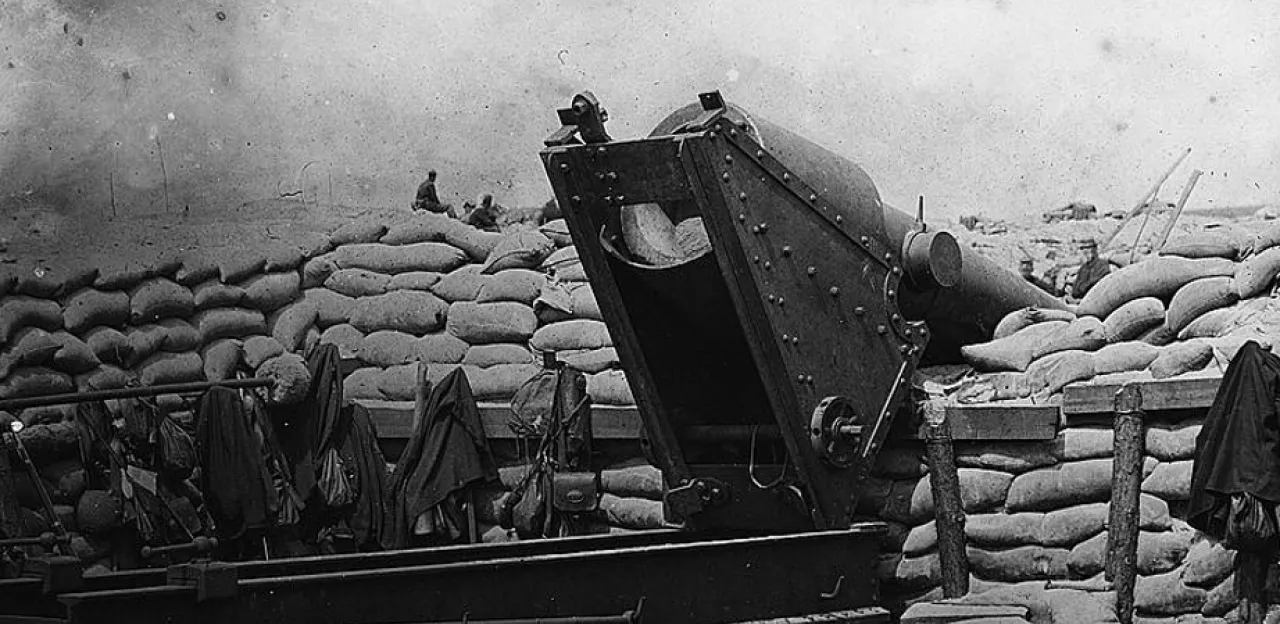
The following text is excerpted from the award winning book, Gate of Hell, Campaign for Charleston Harbour, 1863, By Stephen R. Wise, University of South Carolina Press, 1994 with the gracious permission of the author. Wise is the director of the Museum at Parris Island and a member of the Board of the S.C. Battleground Preservation Trust, Inc.
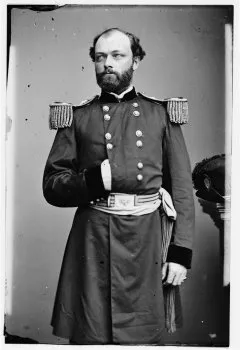
From page 148
The Battery is Constructed
Beside the calcium lights, Gillmore also ordered incendiary shells, commonly called "Greek Fire." Two types of "Greek Fire" were received. One was made by Robert Parrott for use in his cannon, (32 pdr. Parrotts on Morris Island with shells) while the other was known as Short's Solidified Greek Fire. In both cases an incendiary material was placed inside a special shell that was designed to explode over a target and start a fire.
Gillmore planned to use his "Greek Fire" in a battery specifically built to shell Charleston. Shortly after the July 18 (1863) attack, Gillmore instructed Colonel Serrell to explore the possibilities of constructing a battery in the marsh between James and Morris islands. By one account, Serrell gave the duty to a young engineer lieutenant who, after examining the salt marsh, declared the project could not be done. Serrell informed the doubting engineer that nothing was impossible and to requisition any necessary materials. A short time later, Serrell received a request for twenty men eighteen feet tall for work in the marsh. At the same time another request was sent to the department's surgeon asking him to splice three six-foot men together to make the needed eighteen-footers. The requests did not amuse Serrell, and he soon replaced the young officer.
True or not, Colonel Serrell did take over the project and, with assistance from Lieutenant Michie, developed a plan for one of the most unique batteries ever constructed. After seventeen days of personally trudging through the marsh and carrying out tests, Serrell developed a design that Gillmore approved, and on the evening of August 10, the engineers, supported by fatigue parties from the 7th New Hampshire, began work.
The battery was built in two parts. The parapet was constructed first. For its foundation, sheet pilings were driven into the marsh by use of a hand, lever-operated driver. On top of the pilings was bolted a three-sided grillege of logs two layers thick. The grillege surrounded three sides of a rectangular area where the gun platform was to be located.
Placed on the grillege were thirteen thousand sandbags, weighing more than eight hundred tons. The sandbags were carried to the battery by the men of the 7th New Hampshire over a plank causeway two to four feet wide and seventeen hundred yards long. The journey took the men over an hour to complete and many fell off the slippery boards into the marsh. The men from New Hampshire complained that they felt "like a church steeple," as they walked over the planks, attracting the fire of Confederate batteries on James Island.
Once the parapet was completed, work began on the gun platform. Here, Serrell's careful calculations came into play. The platform had to support the weight of a 24,000-pound gun and carriage while not disrupting the parapet. To accomplish this, Serrell did not connect the parapet to the platform. Instead, he designed the battery so its two parts floated on the marsh in equilibrium. To construct the gun deck, the engineers packed down marsh grass, canvas, and sand in the rectangular area formed by the parapet. Then on top of this base they placed a close-fitting plank platform.
The Confederates, from positions on James Island, dimly watched the Northerners working nightly in the marsh and on occasion would lob shells toward the working parties. To confuse the enemy, Serrell had a mock battery established to the south of the real battery. At the same time, log-booms were placed in the surrounding creeks and armed launches watched for any Confederate attacks. During the day, the working parties went back to their camps and rested while a squad of soldiers armed with seven-shot Spencer rides garrisoned the empty battery. Though the guards suffered under long-range bombardments from Southern artillery, the men remained hidden and made no hostile motions except to attack their rations.
While operating in the marsh, the Northerners managed to complete their tasks with little interference from the Confederates. Serrell and the engineers pushed the project toward completion as quickly as possible. The soldiers providing the labor found the work hard, and since they did not understand the reason for the work, they often contemptuously referred to the project as the Marsh Croaker, Mud Lark, and Serrell's Folly.
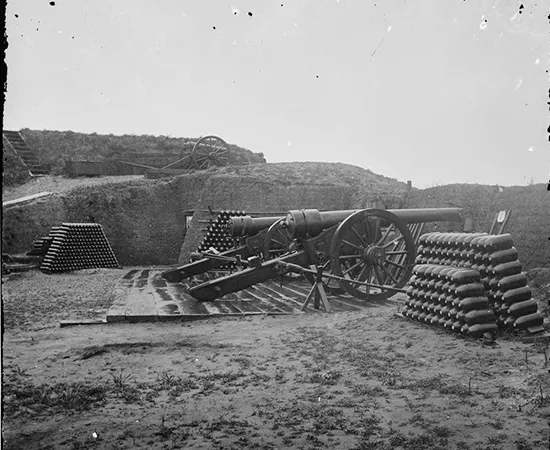
By August 17 the battery was ready for its armament. First the 8,000-pound iron carriage was ferried out to the site, then the huge, 16,300-pound, 8 inch Parrott was taken from the wharf at the southern end of Morris Island and placed on a specially prepared boat. Positioned over the keel, the Parrott weighed the vessel down so that it floated with only five inches of freeboard. The trip to the battery was slow, with water constantly being pumped from the boat, but before daylight, the Parrott was successfully landed and placed on the platform. Four days later, the gun was mounted. Serrell's calculations had been accurate. The downward pressure from the mounted gun did not disturb the parapet, and soon the battery was readied for action.
The battery's garrison was a detachment of the 11th Maine Infantry under Lieutenant Charles Sellmer, who had served nine years in the regular artillery and had attended the artillery school at Fort Monroe before the war. Sellmer's detachment had been called up from Fernandina, Florida, on July 22 for service in the siege lines and, after a few weeks operating mortar batteries, they were assigned to take over Gillmore's marsh battery. On August 21, Sellmer and his men took charge of the work, which was now referred to as the "Swamp Angel," a name given the battery by a member of the 31-0 Rhode Island Artillery. The next evening, Sellmer supervised the unloading of shells, powder cartridges, primers, and other needed implements. While Sellmer readied his gun, engineer Captain Nathaniel Edwards took compass readings on St. Michael's church steeple in downtown Charleston for night firing. Whenever Gillmore was ready, the Swamp Angel was prepared to fire into Charleston.
Why (Gen.) Gillmore erected and used this battery has never been fully explained. In his official report, Gillmore states that the battery was built to drive shipping away from the city's wharves, and at other times, the whole episode seems to take on the atmosphere of a giant experiment in engineering and artillery firing.
By existing rules of warfare, Charleston was a legitimate target. It was an armed camp. There were fortifications in the city. It was home to a number of munition plants, and its wharves served blockade runners who carried war supplies.
But the reasons ran even deeper. To Northerners, Charleston was the symbol of rebellion. It was there that South Carolina officials voted for secession and started the inevitable march toward war. The firing on Fort Sumter, which started the conflict, only increased the North's belief that Charleston was a city of fire-eaters who deserved punishment. For most Northerners, Charleston's destruction seemed just retribution.
The Northern military also wanted redemption. Their impotence during the 1861 Fort Sumter crisis had deeply wounded the pride of many officers. If they could reduce Charleston like the Romans had reduced Carthage, so much the better.
Gillmore was well aware of these attitudes and shared them. He also had a personal motive for firing on the city. His well-laid-out plan had gone awry. He had seen his army shattered on the sands of Morris Island and his own physical condition reduced as the campaign sapped his confidence and energy. Revenge, for the blood of his soldiers, his countrymen, and himself, was also an important factor in his construction and use of the Swamp Angel.
Excerpt beginning page 169
The Swamp Angel Fires into Charleston
On August 21, in the midst of the firing on Fort Sumter, Gillmore received word that the marsh battery, located seventy-nine hundred yards from Charleston, was completed and ready to fire. While the soldiers from the 11th Maine, who made up the gun crew for the marsh battery's 8-inch Parrott, completed their final preparations, Gillmore sent a message by way of Wagner to Charleston, demanding that General Beauregard immediately evacuate Morris Island and Fort Sumter or Charleston would be fired upon. The note reached Confederate headquarters at 10:45 P.M. Beauregard was not present and since the message was unsigned, it was returned for verification.
At 1:30 A.M., August 22, Lieutenant Charles Sellmer, aiming his gun by the compass reading taken on St. Michael's steeple, fired the first round into the city. Before dawn, the Swamp Angel would send sixteen shells into Charleston, with ten containing either Short's or Parrott's "Greek Fire." The resulting flames were clearly seen, and some sharp eared soldiers heard the bells and whistles of Charleston's firemen.
The Shells Land in Charleston
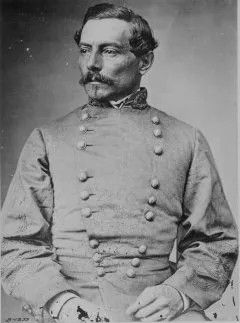
Since the Confederates had ignored Gillmore's note, not believing it was official, no forewarning was given, and the first explosion caused everything from pandemonium to disdainful disgust. At the Charleston Hotel, the British illustrator and journalist Frank Vizetelly was reading a description of the battle of Waterloo when the first shell crashed into the city. Vizetelly quickly moved into the hallway where he found the corridors filled with terrified patrons who were rushing about in the scantiest costumes. As he described the scene: "One perspiring individual of portly dimensions was trotting to and fro with one boot on and the other in his hand, and this was all the dress he could boast of." When another shell exploded, Vizetelly gleefully commented that the entire crowd went "down on their faces every man of them in tobacco juice and cigar ends and clattering among the spitoons.'' Here, he spent the rest of the evening making bets where the next shell would land. As one of the Austrians described the game: "We could hear the whiz of the shells before they passed over our heads, and I bet the Englishman [Vizetelly] a thousand to one that the next shell would not hit us. He took the odds, forgetting that if he won he would be unable to collect his wager, and of course I won my dollar."
Farther down the peninsula from Vizetelly and the Mills House Bar, Williams Middleton was also reacting to the enemy shelling. Middleton, an extremely wealthy plantation owner and avowed Yankee-hater, lived in a large home on the city's Battery where he constantly observed the action on Morris Island from his veranda. When the first shells came into the city, Middleton was in bed, ignoring the enemy fire, then just before he was about to drop off to sleep a neighbor woke him to tell him that the "Yanks were shelling the city." As he described the scene to his wife, Middleton wrote: "As if I did not know it! Can you conceive of anything more absurd? I told him that I felt much obliged to him for taking so much trouble, but that I thought that all we could do was to let them shell and be damned." He then went on to assure his wife that he was perfectly safe. "Little or no damage has been done and not a soul hurt. As soon as they begin our batteries all open upon them and soon make it too hot for them to continue their deviling which is intended I expect for effect in the Yankee news market. "
The next morning at 9 A.M., Gillmore's note, now signed, again reached General Beauregard's headquarters. This time the general was present and an enraged Beauregard sent an immediate reply. The Confederate general considered the firing on the city an act of desperation and barbarity. He wrote: "I am surprised, sir, at the limits you have set to your demand. If, in order to attain the bombardment of Morris Island and Fort Sumter, you feel authorized to fire on this city, why did you not also include the works on Sullivan's and James Islands, nay, even the city of Charleston, in the same demand?" The evacuation of Morris Island and Fort Sumter was refused. The Confederate commander finished by indicating that unless he were given time to evacuate the city's noncombatants, he would use the "strongest means of retaliation. . . ."
Beauregard's demand to allow citizens to leave was backed up by similar requests from foreign consuls. In his answer to Beauregard, Gillmore gave the Confederates one day to clear the city. At the same time, the Federal commander took the opportunity to lecture the Confederates on Charleston's role as an armed camp and munition site, pointing out that it was a legitimate military target and, since the campaign had been going on for forty days, the civilians and military should have known that a bombardment was inevitable.
Throughout the next night, the Swamp Angel remained silent. The gun had slid out of position and had to be moved back into place. During this time, the Union battery came under constant shelling from Confederate mortars, and although the Southerners' aim was accurate, their fuses were too long and the shells would land and bury themselves in the mud before harmlessly exploding.
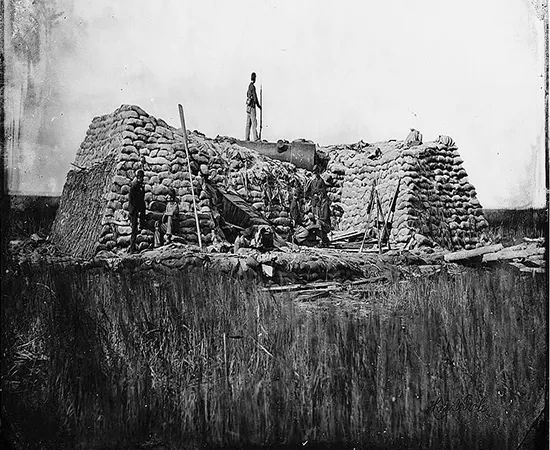
Undeterred by the enemy guns, Sellmer and his men resumed firing on the evening of August 23, again using shells filled with Parrott's or Short's Greek fire. On this night many of the shells exploded in the gun, and after the sixth round, Sellmer found the cannon barrel to be moving in the breech-band. Sellmer had been warned that the Parrott was not a new gun and the exploding shells obviously shortened its life. Afraid that the piece would soon burst, Sellmer tied two lanyards together and positioned his men outside the battery, so if the gun exploded its crew would be shielded from the blast.
With the extended lanyard, Sellmer continued to operate the cannon. After each shot the gun crew would reenter the battery, load the gun, set the primer, and attach it to the lanyard. The men then took cover as Sellmer, pulling on the lanyard, fired the gun. After thirteen more rounds, Sellmer, thinking that the Swamp Angel was still safe, decided to ignore his precautions and stood by the gun to check the time on his watch by the flash of the discharge. On this shot, the breech of the Swamp Angel exploded, throwing the gun onto the parapet. Lieutenant Sellmer and three others were injured, but not seriously, and the Swamp Angel's final shot, the thirty-sixth fired at Charleston, continued on to its target."
The Impact of the Swamp Angel
The Swamp Angel was not replaced during the Morris Island operations, though later a siege gun was located in the Marsh Battery, which was eventually replaced with two mortars. (Similar to these others on Morris Island.) Gillmore later explained that he expected no battlefield victory from the shelling, but felt that valuable artillery techniques were learned. The Swamp Angel accomplished a number of things. It was the first known firing of an artillery piece using a compass reading, and the distance covered by the Swamp Angel's shells was farther than any previous military bombardment.
Gillmore also gained the dubious distinction of being one of the first generals to bombard a civilian center in the hope of achieving a military end. As happened in later years, the shelling of Charleston fueled the defender's hatred for their enemies and provided them an even greater determination. Many civilians had already left the city before the campaign had begun and those that remained merely moved from the city's lower regions to areas out of range of the Federal guns. The city's manufacturing and industrial work continued, and all maritime activity was shifted up river.
In some ways, the Swamp Angel reflected Gillmore's frustration. Though he took satisfaction in shelling the birthplace of the war, Gillmore realized that it was an empty attempt to hurt an enemy who was proving far more resourceful than he had expected.
After the Civil War the remains of the Swamp Angel were transported to Trenton New Jersey, where they were put on display as part of a Civil War Monument which still stands today and had been recently restored.





